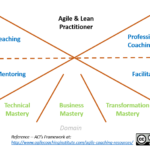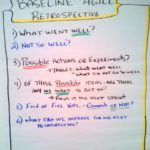Agile Coaching. A seemingly simple term that causes so much confusion. Much of the confusion seems to stem from the reasonable question of “what does an agile coach do?” ACI (Agile Coaching Institute) defined an Agile Coach Competency Framework. I’ve used the framework over the years both for agile coaching and leadership. I find it valuable to help people to understand the different perspectives they can approach agile coaching from. We use the framework as a one tool in Advanced Scrum Master Training (A-CSM) and as one set of approaches and skills in Leading Amazing Teams Training. We find it offers leaders insights into how they can shift from a leader-follower to a leader-leader approach to leadership. ACI had a whitepaper outlining the framework (created by Lyssa Adkins and Michael Spayd on a website – no longer active). This article includes my summary of it based on multiple sources — as well as my personal experience with it and ways to learn from it.
 Jake Calabrese
Jake Calabrese
Agile Coaching: Guiding, Empowering, and Building Sustainable Success
Agile coaching means different things to different people, and I often find myself in conversations about what it really is. To help clarify and share my perspective, I’ve put together key insights based on these discussions. 
What is an Effective Organization?
An effective organization consistently delivers value to customers in a way that retains the great people it has over the long term. It aligns its decisions and actions with its purpose and goals, fosters innovation, adapts to change, ensures financial sustainability, and operates sustainably to remain competitive and impactful. These elements are key to long-term success, though how they take shape depends on the organization’s unique context and challenges.
What is Agile Coaching?
An agile coach helps individuals, teams, and organizations cultivate an effective organization by utilizing agile, lean, and agility. They use a variety of approaches, tools, skills, and competencies to guide clients in aligning their decisions and actions with their own goals while building the capabilities needed for long-term success. Agile coaching is not about agility for its own sake—it’s about using agility to drive real business outcomes, such as customer value, financial sustainability, innovation, and organizational resilience, by creating an environment where people can engage, deliver, and thrive over the long term. A truly effective organization balances financial sustainability with an environment that enables people to do their best work.
Don’t Let a Few Thought Leaders Make Us Stupid
What is a thought leader? If you Google ‘thought leader definition’, you get something like: one whose views on a subject are taken to be authoritative and influential. That seems like a good place to start. While this article applies to thought leaders in general, a few of the references I make are about thought leaders in the agile, leadership, and agility domains.
I will consider types of thought leaders, why they make us stupid, and how we can help ourselves as well as thought leaders improve!
The Real Baseline Agile Retrospective Format
I always considered this six question format to be the Baseline Agile Retrospective Format. I say baseline instead of standard because a baseline is something to build on, not an ‘always the way’ standard (I know I’m splitting hairs here).
I believe the six question baseline agile retrospective format is a solid way to teach people how to do an agile retrospective. They can see, relatively clearly, the different parts that should be included. It can be a useful starting point to address additional questions and challenges.
Bad Standard: Plus-Minus-Delta Agile Retrospectives
Many people dislike the 3 question, plus-minus-delta retrospective. I am one of them. The plus-minus-delta agile retrospective leads to many problems. I say it was never the “standard” in the title, so why are so many people confused? Or…am I the one confused?
While co-coaching recently, the other coach and I had a brief exchange about how the “standard” agile retrospective was not good. I was a little confused, since while I certainly do not always use ‘the standard’ or baseline agile retrospective, there is value to it — at least I thought so? The baseline retrospective I employ is a solid method to teach people how to do an agile retrospective. I asked a few more questions and realized that while we were both using the term “standard retrospective,” we had different definitions of the term.
Cursing Your Vision Statement
I was coaching someone a while back and asked them to tell me what their vision statement: what motivated him? When I heard the answer, I was not moved. What I heard was boring. I knew this person had passion for what he did. What happened to it?
If I ask you to tell me why you do what you do, and you are not jumping up and down a bit, getting a bit fired up, I don’t buy your passion! Here are some ideas to find the passion in your vision statement. They may not be for everyone, but I know they have helped some people already, so I wanted to share.
Improving Yourself with StrengthsFinder 2.0
I am often asked by folks I’m coaching for ideas of assessments they can take to help them grow.
I’m working on a few articles about different types of assessments and improving yourself (subscribe if you are interested in being notified). I thought I’d take some time to explain some of insights I got from taking the StrengthsFinder® 2.0 assessment a while back, as well as explain what it is and how to take it. This is the first of three articles on assessments. The other two will cover MBTI® and The Leadership Circle Profile® . All three are very different in a number of ways, which I will discuss in those articles.
Agile and Agility are about people, learning, and collaborating – a foundational part being able to collaborating and learning with others is personal mastery.
Learning with Fist of Five Voting
Fist of Five Voting is a deceivingly simple process you can use to check-in, learn, gain consensus, and/or vote to understand where people stand on an issue or idea. I say deceivingly, because there is so much more you can learn about what is really happening in a team if you are paying attention.
I find there are many tools I (and others) use without being entirely sure of the idea’s origin. As I work on other articles, I realize some people may not be familiar with concepts such as Fist of Five Voting. So I’m working on building these ideas out to fill in those gaps. The source of Fist of Five is sometimes attributed to American Youth Foundation, however I can’t find a reference on their website.
Lessons-Learned vs Project Retrospectives
I wrote about agile team retrospectives in a recent article and find that the term retrospective can be used in many different ways. I’ve heard people ask, “Did you just change the name from lessons-learned to retrospective?” Although there are similarities, there are some key differences. Let’s review a few types and consider the issues with most lessons-learned meeting.
Release and Project Retrospectives
While agile team retrospectives have a team focus on celebrating, learning, and improving their relationship on a regular basis, there are other types of retrospectives.
Agile Retrospectives Improve Team Relationships
I get a lot of questions about agile retrospectives from existing clients who are familiar with agile, those new to it, and folks who don’t use agile (so, yes: everyone!). This is one in a series of posts on retrospectives covering a variety of angles on the subject. [Agile Retrospective Resources has a list of the upcoming articles and many other resources.]
What is an agile retrospective?

An agile retrospective (often simply called a retro) is a regular ritual focused on celebrating, learning, collaborating, committing, and improving the team’s relationship. These items, taken together form the value of an agile retrospective. There are different types of retrospectives (e.g. release and project retrospectives); though here I am focusing here on regularly scheduled team retrospectives (e.g. sprint retrospectives or iteration retrospectives).









